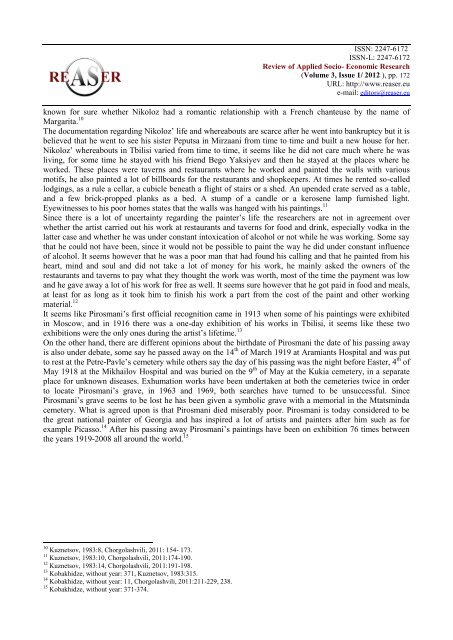Volume 3, ISSUE1/2012 - Review of Applied Socio-Economic ...
Volume 3, ISSUE1/2012 - Review of Applied Socio-Economic ...
Volume 3, ISSUE1/2012 - Review of Applied Socio-Economic ...
Create successful ePaper yourself
Turn your PDF publications into a flip-book with our unique Google optimized e-Paper software.
ISSN: 2247-6172<br />
ISSN-L: 2247-6172<br />
<strong>Review</strong> <strong>of</strong> <strong>Applied</strong> <strong>Socio</strong>- <strong>Economic</strong> Research<br />
(<strong>Volume</strong> 3, Issue 1/ <strong>2012</strong> ), pp. 172<br />
URL: http://www.reaser.eu<br />
e-mail: editors@reaser.eu<br />
known for sure whether Nikoloz had a romantic relationship with a French chanteuse by the name <strong>of</strong><br />
Margarita. 10<br />
The documentation regarding Nikoloz’ life and whereabouts are scarce after he went into bankruptcy but it is<br />
believed that he went to see his sister Peputsa in Mirzaani from time to time and built a new house for her.<br />
Nikoloz’ whereabouts in Tbilisi varied from time to time, it seems like he did not care much where he was<br />
living, for some time he stayed with his friend Bego Yaksiyev and then he stayed at the places where he<br />
worked. These places were taverns and restaurants where he worked and painted the walls with various<br />
motifs, he also painted a lot <strong>of</strong> billboards for the restaurants and shopkeepers. At times he rented so-called<br />
lodgings, as a rule a cellar, a cubicle beneath a flight <strong>of</strong> stairs or a shed. An upended crate served as a table,<br />
and a few brick-propped planks as a bed. A stump <strong>of</strong> a candle or a kerosene lamp furnished light.<br />
Eyewitnesses to his poor homes states that the walls was hanged with his paintings. 11<br />
Since there is a lot <strong>of</strong> uncertainty regarding the painter’s life the researchers are not in agreement over<br />
whether the artist carried out his work at restaurants and taverns for food and drink, especially vodka in the<br />
latter case and whether he was under constant intoxication <strong>of</strong> alcohol or not while he was working. Some say<br />
that he could not have been, since it would not be possible to paint the way he did under constant influence<br />
<strong>of</strong> alcohol. It seems however that he was a poor man that had found his calling and that he painted from his<br />
heart, mind and soul and did not take a lot <strong>of</strong> money for his work, he mainly asked the owners <strong>of</strong> the<br />
restaurants and taverns to pay what they thought the work was worth, most <strong>of</strong> the time the payment was low<br />
and he gave away a lot <strong>of</strong> his work for free as well. It seems sure however that he got paid in food and meals,<br />
at least for as long as it took him to finish his work a part from the cost <strong>of</strong> the paint and other working<br />
material. 12<br />
It seems like Pirosmani’s first <strong>of</strong>ficial recognition came in 1913 when some <strong>of</strong> his paintings were exhibited<br />
in Moscow, and in 1916 there was a one-day exhibition <strong>of</strong> his works in Tbilisi, it seems like these two<br />
exhibitions were the only ones during the artist’s lifetime. 13<br />
On the other hand, there are different opinions about the birthdate <strong>of</strong> Pirosmani the date <strong>of</strong> his passing away<br />
is also under debate, some say he passed away on the 14 th <strong>of</strong> March 1919 at Aramiants Hospital and was put<br />
to rest at the Petre-Pavle’s cemetery while others say the day <strong>of</strong> his passing was the night before Easter, 4 th <strong>of</strong><br />
May 1918 at the Mikhailov Hospital and was buried on the 9 th <strong>of</strong> May at the Kukia cemetery, in a separate<br />
place for unknown diseases. Exhumation works have been undertaken at both the cemeteries twice in order<br />
to locate Pirosmani’s grave, in 1963 and 1969, both searches have turned to be unsuccessful. Since<br />
Pirosmani’s grave seems to be lost he has been given a symbolic grave with a memorial in the Mtatsminda<br />
cemetery. What is agreed upon is that Pirosmani died miserably poor. Pirosmani is today considered to be<br />
the great national painter <strong>of</strong> Georgia and has inspired a lot <strong>of</strong> artists and painters after him such as for<br />
example Picasso. 14 After his passing away Pirosmani’s paintings have been on exhibition 76 times between<br />
the years 1919-2008 all around the world. 15<br />
10 Kuznetsov, 1983:8, Chorgolashvili, 2011: 154- 173.<br />
11 Kuznetsov, 1983:10, Chorgolashvili, 2011:174-190.<br />
12 Kuznetsov, 1983:14, Chorgolashvili, 2011:191-198.<br />
13 Kobakhidze, without year: 371, Kuznetsov, 1983:315.<br />
14 Kobakhidze, without year: 11, Chorgolashvili, 2011:211-229, 238.<br />
15 Kobakhidze, without year: 371-374.








